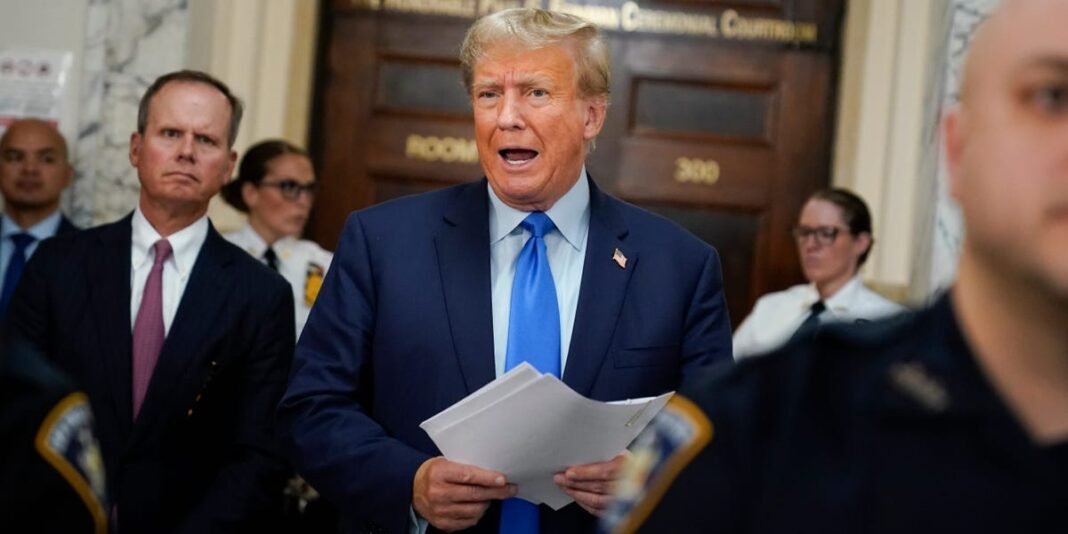It’s the end of an error. Or, by New York Attorney General Letitia James’ count, it’s the end of at least 200 errors.
According to the latest report from his court-mandated fraud monitor, Donald Trump is officially through with boasting about his wealth in those wildly exaggerated net-worth statements he used to send out each year.
In fact, Trump is calling it quits on officially stating the value of even his individual properties, the report says. He is finished, in other words, with saying “I’m rich” in any financial document that could come back to bite him.
Trump’s fraud monitor, Barbara Jones, revealed this new commitment to caution in a footnote to her latest report, made available in online court records last week.
Jones is the retired federal judge who has been monitoring Trump’s real-estate empire, the Trump Organization, for almost two years, ever since the AG and state Supreme Court Justice Arthur Engoron found persistent fraud in a decade of those annual net-worth statements.
“Based on discussions with the Trump Organization, my understanding is that the Trump Organization does not intend to develop any estimations of value for any entity, the Trump Organization as a whole, or the guarantors’ collateral,” Jones wrote.
Any lender or “counterparty” who needs assurance of Trump’s worth will be told to just do their own appraisals.
“Should a need arise to determine the value of any such entities or assets, the Trump Organization would first advise the counterparty that it should develop its own estimation of value (which may be based on information or access provided by the Trump Organization),” the footnote said.
As an alternative, “the Trump Organization would retain an independent appraiser to develop an estimate of value,” the footnote continued.
Business Insider
The decision to stop announcing his worth each year is a departure for Trump. He has issued these net-worth statements — 20- to 30-page balance sheets formally called Statements of Financial Condition — since at least 2004.
According to evidence and testimony in James’ five-year fraud case, Trump sent these “SOFCs” to anyone he hoped to dazzle.
He sent them to Forbes each year in hopes of a good spot on their “400 Richest People In America” list.
He sent them to insurers in hopes of lowering his premiums. And he sent them to banks he hoped would approve low-interest loans for a range of endeavors, including his 2014 bid to purchase the Buffalo Bills and the development of his golf courses and of his luxury hotel in Washington, DC.
“Hopefully, you will be impressed!” Trump wrote to a Deutsche Bank executive in a cover letter to his 2011 net-worth statement, which the AG would eventually show had exaggerated his net worth by $2.7 billion.
Business Insider
Not everyone trusted Trump’s numbers, including his own outside accounting firm, Mazars USA. The firm declared the whole previous decade’s worth of net-worth statements unreliable in 2022, saying it would stop preparing them.
Deutsche Bank, Trump’s most proficient lender, also took the statements with a grain of salt, even while lending him more than $400 million ($125 million for his Miami golf resort, $107 million for his Chicago skyscraper, and $170 million to turn the Old Post Office in Washington, DC into a luxury hotel).
The bank typically lowered Trump’s numbers by set percentages — adjustments they called a “Trump haircut” — in large part to account for what they presumed were his exaggerations.
Forbes, too, carefully fact-checked the statements, adjusting Trump’s worth down accordingly. It was the magazine that first discovered Trump had been claiming for five years — in statements issued from 2012 to 2016 — that his Trump Tower triplex penthouse in Manhattan was 30,000 square feet when it’s actually just under 11,000 square feet.
“A discrepancy of this order of magnitude, by a real estate developer sizing up his own living space of decades, can only be considered fraud,” Engoron wrote in a consequential September pretrial fraud finding.
Every statement Trump issued between 2011 and 2021 was eventually found to be riddled with wildly-exaggerated frauds by first by James’ team of lawyers and investigators, and then by the trial judge, Engoron.
In that decade, the statements added from $1.9 billion to as much as $3.6 billion in fantastical padding each year. There were some 200 misrepresentations in all, James said.
New York attorney general’s office
Throughout the decade’s worth of net-worth statements, Trump ignored generally accepted accounting principles, the AG and judge found.
He claimed he had cash on hand he didn’t have. He ignored appraisals, deed limitations, zoning restrictions, and rent-control mandates that should have significantly lowered his property values. He changed his appraisal methodology without notice, and included intangible things like “brand value” despite saying in the statements that he hadn’t done so.
The frauds continued throughout the five years James spent sending out subpoenas, taking depositions, checking the math, and taking Trump to trial.
Trump’s “I’m rich” boasts continued too, just not on paper after the 2021 statement.
“We have a lot of cash,” he told James in a deposition in April, 2023, a half-year before the trial started.
“When we testify,” he added, “we’re going to have numbers that are going to knock your socks off.”
Ultimately, the most sock-knocking number would come from the judge, who said this of Trump’s net-worth statements: “The frauds found here leap off the page and shock the conscience.”
Trump has been ordered to personally pay back $454 million in ill-gotten gains, plus accrued interest — money he pocketed by deceiving his banks and insurers.
The amount he owes to the state of New York will continue to rise by nearly $112,000 in interest each day — or by $1 million every nine days — as his appeals work their way through the courts over the next few years.
On Thursday, his debt to the state stood at $471 million.


